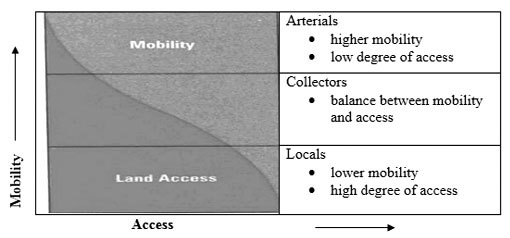
Urgency for formulating Urban Roads Classification System
Md Shamsul Arefin | Saturday, 8 August 2015

The urban roads are classified according to the type and character of service they provide or in agreement with their functions and capacities. Although, the exact nomenclature differs among countries, the basic hierarchy of a modern city comprises: freeways/motorways (mainly in the developed nations), arterials (termed as main road in this country), collectors/distributors, and local roads/streets. The functional classification or hierarchy of roads assists in establishing road design features, formulating policy on land use planning, traffic density, mobility, safety, and degree of access requirements. One of the key objectives of the hierarchy is to optimize accessibility, connectivity, amenity and safety for all road users. Grouping roads with similar functions can improve transportation planning, road infrastructure design, maintenance, and traffic and road operations. The road hierarchy restricts or eliminates direct connections between certain types of links, for example, link between local roads and arterial roads due to overleaping hierarchy (because collector/distributor road serves in-between), and allows connections between similar order roads. For example, arterial to arterial or between road types that are separated in hierarchy by immediate one level, collector to arterial (as shown in the Figure). An ordering of roads and their classification can include several levels and finer distinctions between, for example, major and minor arterials or major and minor collectors rather than arterial and collector roads.
A well formed road hierarchy will reduce overall impact of traffic by: (i) concentrating longer distance flow onto routes in less sensitive locations, (ii) ensuring land uses and activities compatible with traffic flow (iii) preserving areas where through traffic is discouraged, (iv) ensuring activities most closely related to frontage development (such as, frontage/service road on arterial roads), which permits social interaction and parking, where environmental and access functions might predominate.
The concept of road hierarchy is deeply embedded within the planning of transport networks. This is a fundamental tool for urban development and road management and integrating road network and land use planning. It is also an urban planning technique for laying out road networks that exclude through-traffic from developed areas.
In this context which is of most concern is the absence of urban road classification system in the country. Those are mainly under the jurisdiction of municipalities and city corporations. While in India, the Indian Roads Congress (IRC) has classified urban road networks into: (i) arterial, (ii) sub-arterial, (iii) collector street, (iv) local street. The absence of the issue which is seriously affecting the urban areas of the country, particularly in the form of:
(1) Ribbon development issue: ribbon development means built-up area along arterial road system. Such development engenders a serious problem for efficient traffic movements and creates safety hazards. It is attractive to developers, because, they do not have to waste money or land space to construct roads and thus turn into a precursor to urban sprawl. The best example is the Dhaka City wherein ribbon development pervaded almost whole road networks. Moreover, road space occupies only 7.5 per cent of the total city area against the minimum requirement of 25 - 30.0 per cent given the very high population density. Accordingly, demolitions of roadside built-up areas are probably the only option to pave the way for recovering the minimum requirement for the development of road infrastructures.
(2) Intersection issue: Intersections are the most important components for an efficient road traffic system. But regrettably, in this country, it has been observed that occupying the most important areas have become agonizingly customary. On the contrary, these areas need to be left vacant for future development of road infrastructure, such as, addition of extra-lanes (auxiliary lanes), which increases the capacity of the intersections. This predicament could be exemplified by the Dhaka City's situation wherein constructions of flyovers in many cases have ended up in shifting of logjam problem to intersections. This is because built-up areas surrounding the intersections have precluded the scope for capacity augmentation of intersections and thus nullified the benefit of flyover constructions in terms of link time optimization.
As for Dhaka City's road hierarchy, DITS and RMMS had categorized the hierarchy. Yet, these classifications are mainly post-implementation oriented, neither properly envisaged in hierarchical order nor even proper functional considerations. That is why they have little scope for applicability. It is anticipated that had well-defined functional road classification system been adopted for the Dhaka City right from the beginning; then hopefully, a planned city would have flourished.
For setting up geometric standards, cars should be considered as the design vehicle instead of rickshaws even for designing lowest hierarchy roads, such as, local roads. It is envisaged that cars would be common transport in future as the country surges ahead with rapid economic growth. As such, footpath is also required for pedestrians' safety. Moreover, accessibility consideration for emergency vehicles, such as, fire fighting vehicles should be incorporated in all roads while preparing geometric standard.
Really, it is a mortifying and perplexing issue to note that urban road classification system has not been formulated after more than four decades of independence. At least the functional classification based on accessibility consideration could be outlined as a pre-emptive move to secure arterial and collector/distributor roads for future development, while geometric standard could be formulated later on. We must ensure that the mistakes committed in the Dhaka City should not happen in other urban areas. The compliance of classification system should be made a mandatory criterion for all urban areas in the country.
As urbanization is spreading all over the country rapidly, road classification system for urban areas should be formulated on urgent basis to stop the rot immediately; which is essentially required for planned urban developments.